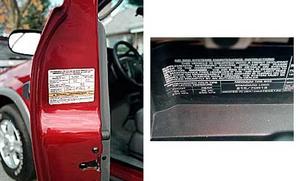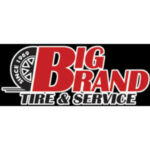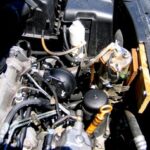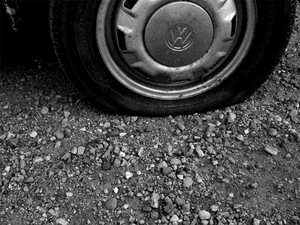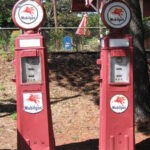A New Answer To An Old Problem?
In today’s age of rising auto fuel prices, it is no wonder that everyone is scrambling to find different ways to save a few dollars at the pump. People like you are paying close attention to anything that may help reduce fuel costs. One of many factors that has a significant impact upon your car’s fuel consumption is proper tire inflation. While there is still plenty of discussion about what constitutes proper tire pressure, it is clear that under-inflated tires result in decreased fuel efficiency. Conversely, many of us know that proper inflation of our car’s tires will lead to lower fuel consumption – which is what we want.
Over time, our tires lose pressure, and the checking and upkeep of proper tire inflation should be part of any car owner’s maintenance routine. Many products and services have arisen to meet the inflation maintenance issue. There are super-accurate tire pressure gauges, remote pressure warning devices – and the list goes on and on to include those nifty “as seen on TV” items… There is also a lot of discussion (some of it very heated) as to how well these gizmos work and whether the inflation issue was properly addressed.
To add fuel to this fire, along comes a new contender: nitrogen gas.
The Skinny On Nitrogen
According to Wikipedia, elemntal nitrogen at ambient temperature and pressure is a colorless, odorless, and tasteless gas. At the molecular level nitrogen is larger than oxygen. It does not react with other chemicals as readily as oxygen, and is mostly not subject to expansion and contraction due to temperature change. Because of these characteristics, nitrogen seems to be a really good high-tech contender as a replacement for air in filling your tires.
Nitrogen: Easy To Use… Saves Fuel and Money…
According to the Get Nitrogen Institute, nitrogen delivers the following benefits for car owners:
* Increased Fuel Efficiency – Correct tire pressure keeps the manufacturer’s recommended “contact patch” on the road. This lessens the rolling resistance and maximizes fuel efficiency.
* Longer Tire Life – When it comes in contact with other materials, oxygen causes oxidation. Oxidation can make rubber brittle and cause it to lose tensile strength. In addition, at high temperatures and pressures, oxygen reacts and damages inner tire liners and belt packages; nitrogen does not.
* Increased Safety – Under-inflated tires cause 90% of blowouts. Nitrogen provides more reliable pressure for reduced blowout potential.
* Longer Rim Life – Rim rust caused by condensation from water vapor and other gases can get caught in tire valves and create slow leaks in tires. Nitrogen is completely dry, so it eliminates the potential for condensation.
* More Predictable Pressure Fluctuation – NASCAR teams use nitrogen so they can more accurately predict tire pressure fluctuation. Regular compressed air can fluctuate considerably when water vapor is present.
What About The Stuff They Didn’t Tell You?
Putting aside the fact that not many of us are NASCAR racers, the above benefits all seem to be solid arguments for hopping onto the nitrogen bandwagon. But stop and look at a few really important things that seem to have been overlooked in the Big Picture:
* Tires were designed for you to fill them with regular air.
* Inflation instructions assume you fill your tires when they are cold.
* There is still conflicting information about proper tire inflation.
Tires Were Designed For You To Fill Them With Regular Air
It goes without saying – since the very first car hit the pavement decades ago, tire manufacturers have used the most readily available gas to inflate tires: good ol’ regular air.
Unlike nitrogen, regular air expands and contracts significantly with changes in temperature due to driving conditions. For example, you can expect your air-filled tires to show an increase in pressure after driving onto hot pavement. Likewise, if you load up on cargo in the trunk (or truck bed), the added weight will cause the tires to “bear down” harder on the road, thus creating more friction, more heat, and a higher tire pressure. There are other factors effecting a tire’s pressure. The basic idea: once you start driving with air-filled tires, heat builds up and tire pressure goes up, too.
Why is all this significant? Because all along your car’s tire manufacturers took these different pressure-generating factors into account – assuming you are using air. As a matter of fact, your tires’ proper inflation count on this extra heat and pressure buildup. However, unlike regular air, nitrogen does not expand with changes in temperature, even long after you hit the road.
This brings us to our next point of concern.
Inflation Instructions Assume We Air-Fill Our Tires When They Are Cold
If you fill your tires with regular air and hit the pavement for 20 miles or more, the actual “operational pressure” of your tires may increase as much as 15 pounds or more. This increase in pressure significantly reduces the rolling resistance of your tires, and this in turn plays into your favor by reducing fuel consumption.
On the other hand, if you filled your tires with nitrogen to your car manufacturer’s recommended “cold tire” pressure in the morning and drove for hours on end, in the afternoon there will have been no notable change in tire pressure. The non-expansive properties of nitrogen account for this lack of pressure buildup.
I recently had my tires changed at a local tire store and requested they be filled with nitrogen. The shop installed the tires, filled them with nitrogen, and I was soon cruising home with my new treads. Before I left, I asked them to what pressure they filled my tires. They answered, “28 pounds” – exactly what my car manual specified. When I got home ten minutes later, I put my hand on one of my tires and found it to be pretty warm – which is to be expected. I checked my tires’ pressure and found them at exactly at 28 pounds. The nitrogen had not expanded, as promised.
But this raised a really legitimate safety question for me: if I inflate my tires- tires that were designed to undergo a pressure buildup – to their “cold tire” pressure using nitrogen, then am I not operating my tires at a dangerously low pressure? After all, the Get Nitrogen Institute tells us:
“Under-inflated tires cause 90% of blowouts.”
The next morning I drove back to the shop and asked the “cold tire” pressure question of the service attendant. His answer: “I don’t know – but for sure the low pressure would make your car eat more gas.” He then added, “It is for this reason that we sometimes overfill the tires with nitrogen to 35 pounds – to simulate the pressure buildup from the heat they would normally have”.
I then asked, “Why didn’t you guys fill my tires to 35 pounds yesterday?” His answer: “I guess we forgot.” He beefed up the pressure for me, and afterwards I drove back home with a notably more solid ride due to the pressure increase.
As a solution to this problem, you may be thinking: why don’t we just inflate the tires with nitrogen at a higher pressure. End of problem, right?
Wrong. This brings us to our next problem.
There Is Still Conflicting Information About Proper Tire Inflation
As you know already, the “official” cold-tire pressure assumes that you’re pumping up with air before you start the engine and roll out the driveway. There is generally nothing wrong with this, but what many of us do not know is what happens to the tires after we start driving.
With regular air, after driving for 20 miles or more the “operational” temperature of your tires may increase by as much as 100 degrees, and pressure may increase by as much as 15 pounds or more. (These figures may fluctuate significantly depending on many factors such as altitude, road friction heat, outside air pressure, whether you’re carrying a load, whether you’re turning and changing directions frequently – the list goes on.)
The fact is: your tires were designed to change pressure to accommodate these variable factors. With the advent of nitrogen, your tires’ need to undergo such stressful changes has been obviated. We are now in a position to inflate our tires to an optimum pressure and count on it staying there at that pressure. The problem now is that there is no stated optimum tire pressure.
Even The Experts Don’t Know
“There is no ‘golden’ tire pressure,” states Oscar Pereda, an engineer for tire manufacturer BFGoodrich. According to Sports Compact Car Pereda goes on to provide a list of gyrations one could follow that might produce a fairly accurate answer:
“First, get a skidpad, and plan to be dizzy. Take your dramamine. Drive in a circle, first one direction, then the other. Measure and record tire temperature distributions with a probe-type pyrometer that actually penetrates the rubber, not the “aim and click” infrared type. You want bulk temperature, not surface temperature, because the surface cools rapidly while the inner temperature is more stable. When measuring tire temperatures, if center is hotter or cooler than shoulders, there is too much or too little pressure, respectively.
Adjust pressures in 2-psi increments and record all adjustments. Adjust pressures by differences. If you start at 30 psi, and want to take out 2 psi, but the tires have heated up and are at 33 psi, set them at 31 psi rather than 28. The sum of all the changes made will be very close to the change from your initial cold setting. To check this, leave the tires alone at the end of the day, let them cool, and check the pressures in the morning. If at any point during the day you “reset” your pressures to some arbitrary starting place, you are suddenly lost, and all the work you have done that day is gone.
The ideal caster and toe alignment settings will give even tire pressures all across the tread. This can be determined in the same way as the optimum tire pressure. You’ll never get the tire temperatures perfectly even, but the best you can do is the best you can do, which is the point of the exercise. What works best will vary from car to car depending on camber curves, body roll, ride height and other factors.”
This sounds like something we all can do during our lunch hour, right?
So, What’s The Real Problem Here?
Nitrogen’s benefits (when used correctly) are clear. The problem is not with using nitrogen. The problem is that by using nitrogen, you may be subjecting your tires to a condition they were never designed to handle: stabilized pressure. By not allowing your tires’ pressure to expand and contract with varying driving conditions (as with regular air), by using nitrogen you may be driving your car with consistently and improperly inflated tires.
Other problems come into play also. In the case of my car’s tires, this was human error. For years the shop technicians who inflated my new tires have been using regular air. Years of conditioning caused them to fill the tires at the (low) “cold tire” pressure. For all I know I could have driven out the door to meet the last few minutes of my life – after having suffered a blowout due to under-inflation.
Enough said. Let’s face it: there is no known optimum tire pressure.
* While towing a trailer at high speeds on a freeway in rush-hour traffic, is this a comforting prospect?
* With a carload of kids, is this a comforting prospect?
The problem this comes down to is the possibly very real risk this poses to you.
Any Solutions?
At this time, it is clear there is no known optimum tire pressure. As consumers, the best we can do is the best we can do.
I can tell you what I did…
I wanted to take advantage of the benefits of nitrogen, yet retain an inflation pressure that would best reflect my average driving conditions. So…
I spoke with several mechanics, some tire sales folks, a few friends with a high mechanical acumen, and I came up with this strategy: I drained out the nitrogen and refilled with regular air. Over two weeks I took several “hot tire” pressure readings to determine the average operating pressure for my new tires. I tried to make sure I took measurements when weather conditions were matching, and at approximately the same time of day so that pavement heat was relatively consistent. Upon determining the average pressure, I went back to the tire shop and had the guys there inflate my tires to this pressure. They suggested I add 2 pounds for the front tires because they carry the heavier end. I went with their suggestion.
So far, everything has been okay. But it’s only been a few weeks. I own a VW Jetta TDI (diesel) and so far I have seen consistently good fuel consumption at this tire pressure – about 45 MPG (assuming I don’t drive too fast – see my other content about how wind speed drastically effects fuel consumption). As promised, I have checked and verified that the pressure in my nitrogen-filled tires does not fluctuate with different driving conditions.
Readily available, impervious to temperature, the benefits of using nitrogen are clear. Because of its imperviousness to temperature, nitrogen might possibly level a playing field that has been the subject of so much argument and ambiguity: proper tire inflation. We can only hope that, with the passage of time and collective experience, car and tire manufactures can come to an agreement as to proper tire inflation pressure – if not for air, then at least for nitrogen.
As a solution for good fuel consumption, nitrogen is great – assuming you choose to leverage a stable and consistent tire pressure that provide the best results.
Happy Driving!
– John Melendez – AC Content Producer
See my other articles at: http://www.associatedcontent.com/user/76423/john_melendez.html
Disclaimer & Safety Notice: Author does not warrant or assume any legal liability or responsibility for the accuracy, safety, completeness, or usefulness of any information, apparatus, product, or process disclosed or referred to. Information is provided for informational purposes only. Any actions taken on the reader’s part are taken entirely at the reader’s own risk. Author shall not be liable for any errors in the content, or for any actions taken in reliance thereon. Furthermore, Author shall not be liable for any loss of profits, contracts, opportunities or any direct, indirect or consequential loss of any kind (including death and/or injury), business interruption or loss of property arising out of or in connection with the use of the information herein.
